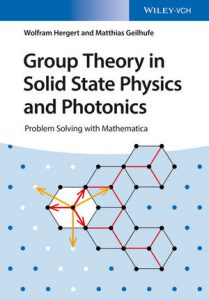Matthias Geilhufe
Om mig
I am working on investigating, identifying, and designing quantum matter, i.e., phases of matter where quantum effects remain dominant over a wide range of energy and length scales, such as superconductivity, topological matter, and Dirac matter. My focus lies on strongly correlated and organic materials. I use a pragmatic approach where I combine methodology of machine learning and materials informatics, ab initio electronic structure calculations, effective models and analytic methods, as well as group theory.
Group Theory Book
A course on group theory in solid state physics and photonics together with a detailed description about the application of our Mathematica group theory package GTPack can be found in our book Group Theory in Solid State Physics and Photonics: Problem Solving with Mathematica. The book contains hands-on examples covering basic group theory to advanced applications.
W. Hergert, M. Geilhufe, Group Theory in Solid State Physics and Photonics: Problem Solving with Mathematica, Wiley-VCH, ISBN: 978-3-527-41133-7, 2018
More information about the book and the Mathematica group theory package GTPack can be found at http://gtpack.org

Research Interests
Materials informatics and Organic Materials Database
We have developed the Organic Materials Database - OMDB, transfering methodology from data science into functional materials research. The OMDB hosts, electronic, crystal, and magnetic structure information of more than 32,000 previously synthesized organic molecular crystals and metal organic frameworks which were obtained by means of high throughput calculations. The OMDB is free to use and contains advanced pattern matching functionality and machine learning based property prediction tools.
The OMDB can be accessed via https://omdb.mathub.io.
Selected publications:
- S. S. Borysov, R. M. Geilhufe, and A. V. Balatsky, Organic materials database: An open-access online database for data mining, PLOS ONE, 12, 2, e0171501 (2017)
- B. Olsthoorn, R. M. Geilhufe, S. S. Borysov, and A. V. Balatsky, Band gap prediction for large organic crystal structures with machine learning, Advanced Quantum Technologies (2019)
Symmetry Principles of Quantum Matter
Quantum matter describes a class of phenomena where quantum effects remain dominant over a wide range of energy and length scales. The realization of quantum matter is typically strongly bound to symmetry, symmetry breaking, and topology. I apply and develop group theory based methodology to investigate quantum matter in the static and time domain, with particular focus on Dirac materials and superconductors.
Selected publications:
- R. M. Geilhufe and W. Hergert, GTPack: A Mathematica Group Theory Package for Application in Solid-State Physics and Photonics, Frontiers in Physics, 6, 86 (2018)
- R. M. Geilhufe and A. V. Balatsky, Symmetry analysis of odd- and even-frequency superconducting gap symmetries for time-reversal symmetric interactions, Physical Review B, 97, 024507 (2018)
Full list of publications
Full list of publications can be found at google scholar.